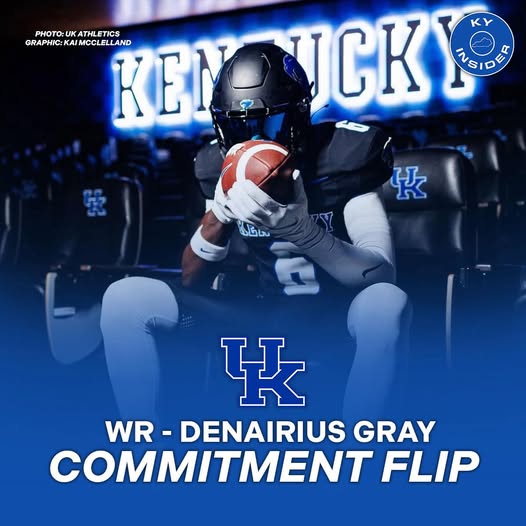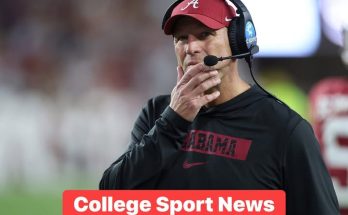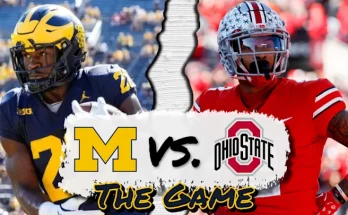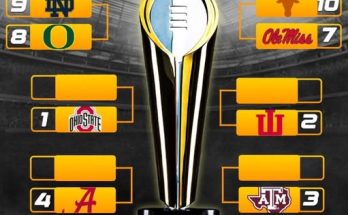The college football recruiting world was rocked on Tuesday when four-star wide receiver Denairius Gray, previously committed to Auburn, made the shocking decision to flip his commitment to Kentucky. This unexpected move sent ripples through the SEC recruiting landscape and left many fans and analysts scrambling to understand what led to such a dramatic change. Gray’s decision highlights the unpredictable nature of recruiting in college football today and raises important questions about the factors that influence top prospects in their quest for the best fit both on and off the field.
Denairius Gray’s recruitment was closely followed throughout the process, as he emerged as one of the most talented and sought-after wide receivers in the class. His combination of size, speed, and catching ability made him an ideal target for many programs looking to bolster their receiving corps. Auburn’s initial commitment from Gray was seen as a major win for the Tigers, who have been eager to re-establish themselves as a powerhouse in the highly competitive SEC West. However, the sudden flip to Kentucky changed the narrative dramatically, shining a spotlight on the Wildcats’ growing ability to compete with traditionally dominant programs in recruiting battles.
At 6-foot-2 and possessing a fluid running style, Gray’s physical attributes caught the eyes of recruiters nationwide. More than just his measurable skills, Gray showed a knack for making contested catches and displaying excellent route running, qualities that will undoubtedly make him an asset in any college offense. His recruitment was one of the most closely watched wide receiver races of the cycle, with Auburn initially seeming to have the edge given their offensive scheme and recent recruiting momentum.
The decision to flip commitments is never easy for a young athlete, especially one as highly ranked as Gray. Recruiting is a dynamic and emotional process that involves constant evaluation of coaching staffs, offensive systems, campus culture, playing time opportunities, academic fit, and family considerations. In Gray’s case, the timing of the switch — just weeks before National Signing Day — was surprising, leaving both Auburn and Kentucky fans stunned. It also underscored the persistent tug-of-war that exists between SEC programs for elite talent.
Kentucky’s rise as a formidable player in the recruiting arena cannot be understated in this development. Historically, Kentucky was seen primarily as a basketball school with sporadic football success. However, under the leadership of head coach Mark Stoops, the Wildcats have steadily improved their football program, emphasizing player development, physicality, and competitive toughness. Recruiting classes have become more impressive year after year, and the program’s ability to flip commitments from established SEC powers is a testament to their growing appeal.
One of the key factors likely influencing Gray’s flip is Kentucky’s reputation for developing wide receivers and giving them meaningful playing time early in their college careers. The Wildcats have seen several receivers flourish in their offense, gaining national attention and improving their draft stock. For a prospect like Gray, the prospect of stepping into a program where he can make an immediate impact and showcase his talents on a weekly basis is highly attractive.
In addition to the football considerations, the academic and social environment at Kentucky may have also played a role. The Wildcats boast a supportive campus atmosphere and offer a variety of academic programs that appeal to student-athletes preparing for life beyond football. For recruits and their families, these factors weigh heavily in the final decision-making process. It’s likely that Gray’s conversations with Kentucky’s coaching staff, current players, and support personnel painted a picture of a program that aligns with his goals both on and off the field.
On the other side, Auburn now faces the challenge of recalibrating their recruiting strategy in the wake of Gray’s flip. Losing a four-star wide receiver commitment can have a ripple effect, not only impacting the immediate roster plans but also sending signals to other recruits watching the situation unfold. Auburn’s coaching staff will need to redouble efforts to secure other top targets and reassure their fan base that the Tigers remain a destination for elite talent. This event may serve as a catalyst for Auburn to evaluate how they communicate with recruits and manage their relationships during the critical signing period.
The recruiting landscape in college football has evolved significantly with the advent of social media, NIL (Name, Image, Likeness) opportunities, and increased transparency around coaching changes and program direction. Prospects like Gray have more information and influence than ever before, enabling them to make decisions that best fit their personal and athletic aspirations. This empowerment has increased the frequency of commitment flips and surprises in recruiting cycles, making every decision closely watched and analyzed by fans and media alike.
Looking ahead, Denairius Gray’s flip to Kentucky could have lasting implications beyond just this recruiting class. It may embolden Kentucky to continue challenging SEC norms, proving that they can secure top-tier talent even against established powerhouses. For Auburn, it serves as a reminder of the volatile nature of recruiting battles and the importance of maintaining strong connections with recruits throughout the process.
From a broader perspective, Gray’s decision is emblematic of the shifting dynamics in college football recruiting, where traditional hierarchies are being challenged by emerging programs investing in facilities, coaching, and player development. This creates a more competitive environment where recruits are the true winners, able to weigh multiple appealing options before committing to the program that best suits their ambitions.
the flip of four-star wide receiver Denairius Gray from Auburn to Kentucky is a headline-grabbing move that reflects the complexities and high stakes of modern college football recruiting. Gray’s physical talent and potential make him a valuable addition to Kentucky’s roster, and his decision to switch commitments highlights the Wildcats’ growing stature in the SEC. Meanwhile, Auburn must regroup and push forward to maintain its recruiting momentum in one of the nation’s most competitive conferences. For fans, coaches, and analysts, this development is a compelling reminder that in the high-stakes game of college football recruiting, nothing is guaranteed until the ink is dry and the National Signing Day window closes. The ripple effects of Gray’s choice will be felt for years to come, shaping the trajectories of both programs as they vie for supremacy in the Southeastern Conference.



